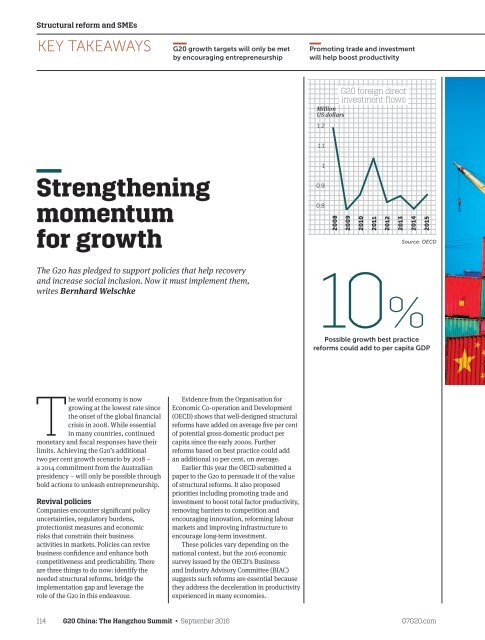G20 china_web
You also want an ePaper? Increase the reach of your titles
YUMPU automatically turns print PDFs into web optimized ePapers that Google loves.
Structural reform and SMEs<br />
KEY TAKEAWAYS<br />
<strong>G20</strong> growth targets will only be met<br />
by encouraging entrepreneurship<br />
Promoting trade and investment<br />
will help boost productivity<br />
Million<br />
US dollars<br />
1.2<br />
<strong>G20</strong> foreign direct<br />
investment flows<br />
1.1<br />
Strengthening<br />
momentum<br />
for growth<br />
1<br />
0.9<br />
0.8<br />
2008<br />
2009<br />
2010<br />
2011<br />
2012<br />
2013<br />
2014<br />
2015<br />
Source: OECD<br />
The <strong>G20</strong> has pledged to support policies that help recovery<br />
and increase social inclusion. Now it must implement them,<br />
writes Bernhard Welschke<br />
10%<br />
Possible growth best practice<br />
reforms could add to per capita GDP<br />
The world economy is now<br />
growing at the lowest rate since<br />
the onset of the global financial<br />
crisis in 2008. While essential<br />
in many countries, continued<br />
monetary and fiscal responses have their<br />
limits. Achieving the <strong>G20</strong>’s additional<br />
two per cent growth scenario by 2018 –<br />
a 2014 commitment from the Australian<br />
presidency – will only be possible through<br />
bold actions to unleash entrepreneurship.<br />
Revival policies<br />
Companies encounter significant policy<br />
uncertainties, regulatory burdens,<br />
protectionist measures and economic<br />
risks that constrain their business<br />
activities in markets. Policies can revive<br />
business confidence and enhance both<br />
competitiveness and predictability. There<br />
are three things to do now: identify the<br />
needed structural reforms, bridge the<br />
implementation gap and leverage the<br />
role of the <strong>G20</strong> in this endeavour.<br />
Evidence from the Organisation for<br />
Economic Co-operation and Development<br />
(OECD) shows that well-designed structural<br />
reforms have added on average five per cent<br />
of potential gross domestic product per<br />
capita since the early 2000s. Further<br />
reforms based on best practice could add<br />
an additional 10 per cent, on average.<br />
Earlier this year the OECD submitted a<br />
paper to the <strong>G20</strong> to persuade it of the value<br />
of structural reforms. It also proposed<br />
priorities including promoting trade and<br />
investment to boost total factor productivity,<br />
removing barriers to competition and<br />
encouraging innovation, reforming labour<br />
markets and improving infrastructure to<br />
encourage long-term investment.<br />
These policies vary depending on the<br />
national context, but the 2016 economic<br />
survey issued by the OECD's Business<br />
and Industry Advisory Committee (BIAC)<br />
suggests such reforms are essential because<br />
they address the deceleration in productivity<br />
experienced in many economies.<br />
114 <strong>G20</strong> China: The Hangzhou Summit • September 2016 G7<strong>G20</strong>.com
















